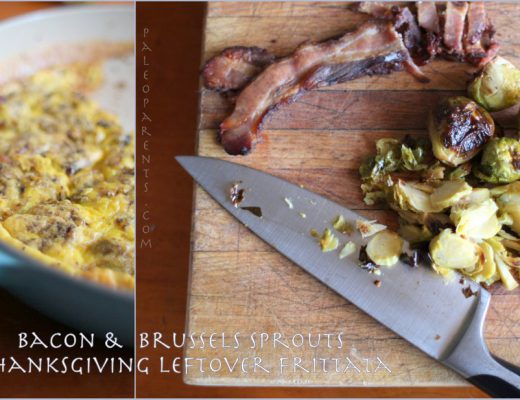

At some point in human history, we determined that picking leaves off plants and eating them was one of the healthiest things we could do. Of course, the healthiest foods are often not the most appealing, so the idea of eating salad became a joke. If you order a *gasp* salad at a restaurant instead of a steak, your dining companions are sure to ask you if you are on a diet. And of course there’s this.
But still, getting in your greens is important, so we’d like to share with you how to build a great, tasty salad that you’ll be happy to eat at your desk, at the dinner table, or at a picnic.
 Salad with Raspberry Vinaigrette from Real Life Paleo
Salad with Raspberry Vinaigrette from Real Life Paleo

I suppose you may not be convinced of the importance of eating salads, so perhaps you ought to know some facts.
 Veggies to start the day sets you up for success, try the Breakfast Salad from Real Life Paleo
Veggies to start the day sets you up for success, try the Breakfast Salad from Real Life Paleo
- Salads are high in fiber
As your prune eating aunt knows, fiber is key to a healthy digestive system and it’s something that is often missing in a grain-free diet. Fiber is also linked with lower blood cholesterol as well. - Salads are a great source of anti-oxidants
Eating lots of vegetables, particularly raw ones, will mean consuming lots of Vitamin A, Vitamin C, beta-carotene and lots of other protective nutrients. - Salads are filling without being high calorie.
You can eat a lot of lettuce without overindulging! - Vegetables help reduce your risk of cancer, especially for those consuming a high protein diet.
And what about the dressing? Well, it turns out that the fats in the high quality oils used in good salad dressing (like olive oil, avocado oil, and nut oils) have a high proportion of monounsaturated fats, which is considered an extremely healthy type of fat.
 Ranch Dressing from Real Life Paleo
Ranch Dressing from Real Life Paleo

Tips
So what are the important ingredients of a salad and how do you assemble it?
 This Winter Salad from Real Life Paleo uses greens, butternut squash, clementines, and almond slices.
This Winter Salad from Real Life Paleo uses greens, butternut squash, clementines, and almond slices.
- Greens
If your farmer’s market is not yet filled with local greens, we do live in a glorious age of supermarket salad mixes. This is one of the places we recommend you don’t skip on organic. It’s not that much more expensive. You can get precut, washed and ready to go greens in clamshell containers at most stores these days. We enjoy spring mix, baby spinach, arugula, red lettuce and butter lettuce. - Herbs
Add some herbs for flavor! We like mint, cilantro, basil, or sorrel. - Raw Vegetables
Classic added vegetables include carrots (ribbons or shredded), cucumber (quartered or shredded), avocado (chunks or sliced), peppers (diced or sliced), tomatoes (diced, wedges or cherry sized), and zucchini (ribbons, diced, or shredded). Play with different textures! For example, Stacy hates carrot rounds with a passion, but loves carrot ribbons. - Nuts and Seeds
We enjoy adding some almond slivers, sunflower seeds, pepitas, or walnuts to our salad for a bit of extra crunch which also adds protein and fat. - Fruit
Add a handful of dried cranberries, blueberries, cherries, raisins or strawberries to your salad. They will add extra nutrients and a bit of sweetness. This is particularly effective with our kids – they LOVE salads with even a small amount of dried fruit! - Protein
For us, adding protein turns a salad from a side dish to a meal. Add leftover shredded chicken or pork, or Stacy’s favorite wild canned salmon and tuna, or just hard boiled eggs to make your salad a perfect lunch!
 Warm Spinach Salad with walnuts, dates, and bacon from Real Life Paleo
Warm Spinach Salad with walnuts, dates, and bacon from Real Life Paleo
Salad Dressing
There are two main types of salad dressing: creamy and vinaigrette.
The vinaigrette is an emulsion made with part vinegar, part oil. Traditionally, the ratio is 3 parts oil to 1 part vinegar. The trick is to change what ingredients make of those two main ingredients. Do you want to use olive oil or avocado oil or sesame oil or almond oil? Do you want to use red wine vinegar or rice vinegar or balsamic vinegar? Without an emulsifier, your dressing will separate. Use a teaspoon of dijon mustard if you’d like to keep it together.
There are also creamy dressings, which are essentially all mayonnaise based. You can make these dressings as you make the mayonnaise, simply add flavorings afterwards. Lots of different flavorings can go into these dressings, like anchovies in a Caesar or dill in a Ranch.
We have a ton of recipes for dressings in our book, Real Life Paleo – including, Honey Mustard, Caesar, Ranch, and Raspberry Balsamic. Today with share with you a NEW recipe for absolutely amazing Asian Vinaigrette.

Tools
You’re going to want a salad dressing cruet (bottle). Growing up, we had the greatest cruet ever invented: the Good Seasons glass bottle that came with their salad dressing mix. It was perfect! Great shape, great spout, and it had gradations for oil and vinegar etched into the bottle itself. I was so happy to get one for myself as an adult and I use it as a guide for all my dressings. Of course, simple mason jars also work extremely well!
Other versions will also have recipes on the side like this one, but I much prefer the simplicity of the Good Seasons classic.
 Caesar Dressing from Real Life Paleo
Caesar Dressing from Real Life Paleo
Stacy uses her grandmother’s antique mason jars for photos, but I assure you our food is never that pretty.

The other night we had a bunch of leftovers from our sushi night, including tuna, carrots, cucumber and avocado. At the same time Stacy wanted a salad. So I threw together a sushi-inspired salad with greens, avocado, cucumber, carrots, and tuna. Stacy loved it and wanted to post it on Instagram. When she asked if it should go on the blog, I said, “It’s four ingredients and a salad. Why would anyone be interested in that?” Well, apparently plenty of people would, because overwhelmingly people wanted to know what was in there. So here I present to you my world famous “Four Ingredients and a Salad”.

Ingredients
- 4 C Spring Mix salad
- 1 medium carrot, peeled, then ribboned with a peeler
- 1/2 avocado, sliced
- 1/2 C diced cucumber
- 1 C micro greens (optional for added crunch)
- 1 tuna filet or steak (about 3/4 lb), sushi grade or previously frozen
- 1/3 C black sesame seeds
- 1/2 Tbsp salt
- 1 tsp grated fresh ginger
- 1/2 tsp garlic powder
- 1/4 tsp ground black pepper
- 1/2 C avocado oil
- 1/3 C rice vinegar
- 2 Tbsp sesame oil
- 1 Tbsp tamari or coconut aminos
Instructions
- In a wide bottomed bowl, combine seasonings for the tuna. Stir to mix and spread evenly on bottom of the bowl.
- Press and coat tuna with seasoning mixture.
- In a cast iron skillet, sear tuna on each side over medium-high heat, about 3-4 minutes per side. Tuna will still be raw inside.
- Slice tuna in 1/2 inch slices.
- In a jar, shake together ingredients for salad dressing.
- Toss salad ingredients, top with tuna and serve with dressing.
Please note, if raw tuna makes you nervous or is too cost prohibitive, this recipe would still be delicious with high quality canned tuna. Stacy’s been using the Asian Vinaigrette on her work lunch salads and says it’s highly recommended. Simply add the sesame seeds to the top, voila!
 Stacy prefers Wild Planet No Salt Added Canned Tuna or Bear & Wolf Wild Salmon as part of her daily lunch salad routines.
Stacy prefers Wild Planet No Salt Added Canned Tuna or Bear & Wolf Wild Salmon as part of her daily lunch salad routines.




